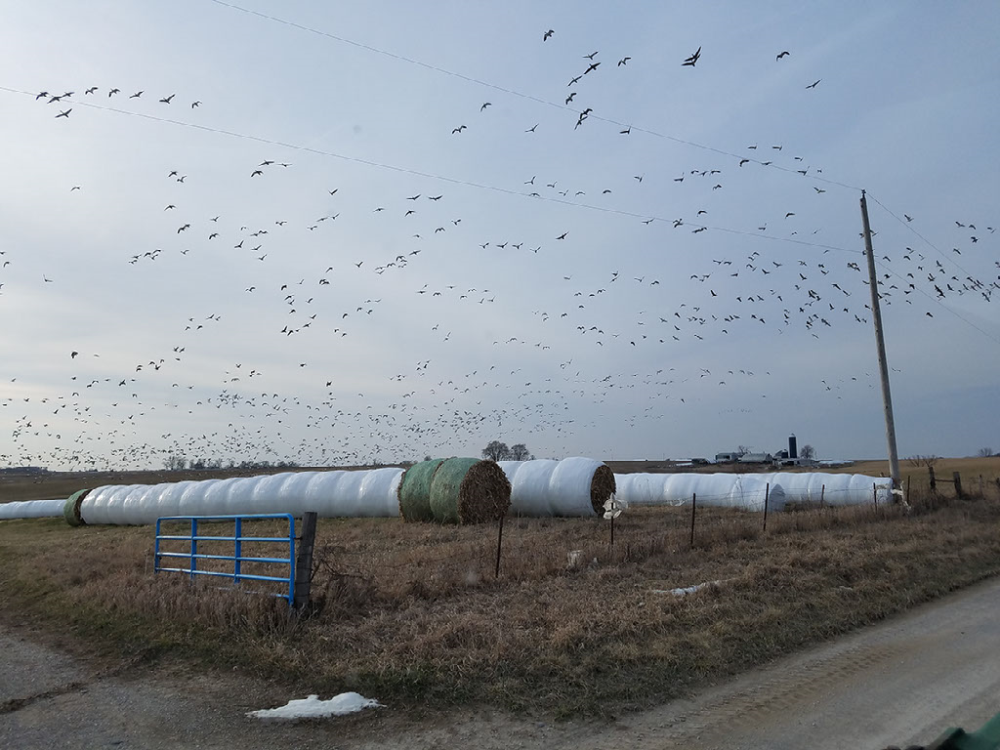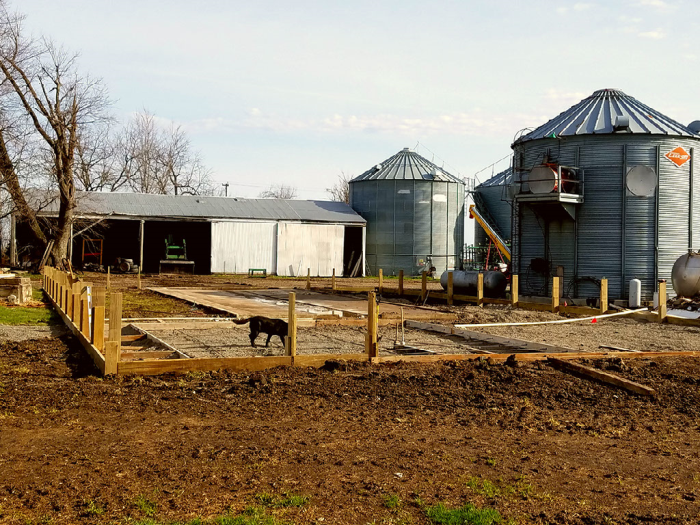Farm Life Journal - April 2017
April 17, 2017
By Mark Jackson
 My tulips, daffodils and crocus have emerged along with the arrival of April showers. Add columbine, bleeding hearts and lilacs to that list of early spring flowers and we are well on our way to a new growing season here in southern Iowa. Where has the “off season” gone? Busy around the farm would be an understatement.
My tulips, daffodils and crocus have emerged along with the arrival of April showers. Add columbine, bleeding hearts and lilacs to that list of early spring flowers and we are well on our way to a new growing season here in southern Iowa. Where has the “off season” gone? Busy around the farm would be an understatement.
My never-ending list of projects is constantly reviewed and updated. Self-motivation is essential when you are your own boss and employee, a challenge within itself. I’ve come close to firing myself a few times over the years but didn’t have anyone to replace me, so here I am. I’m thankful my son and family have joined our family farm partnership several years back. Age may bring wisdom, but with youth comes a renewed energy and the combination is unbeatable. Welcome to the world of agriculture, a legacy of hands across generations. The following link is my personal story: https://www.ted.com/watch/ted-institute/ted-unilever/mark-jackson-a-personal-story-about-farming-and-the-future-of-agriculture.

Life is good when your dinosaurs are all in a row, paraphrased after one of the grandchildren successfully lined up an assortment of toys. His smile told the whole story and it’s with that same optimism that U.S. farmers face the seasonal challenges of food production. In the weeks ahead, Iowa farmers, known as world class leaders in the production of grains and livestock, will plant some 24 million acres of corn and soybeans. And with the enhanced value of that production, we fill grocery stores, feed livestock, fuel vehicles and export mega ships full of grain to dozens of countries around the world.
U.S. agriculture is unique in our proactive sustainability protocols of continual improvement — it’s a journey, never a destination.
I can personally attest to the improvement in the environmental sector. As a child back in the early ‘60s, I can remember the neighborhood excitement in seeing geese flying over in the classic v-shaped formation or deer tracks in a freshly tilled field. Today, these are common place, along with a broad range of species in abundance. But co-existing with Mother Nature can often come at a cost to the farmer, mostly in the form of crop damage. The revival of cover crops has become a magnet for wildlife, providing food and habitat in addition to the clean water benefits of reducing erosion and banking nutrients.

7 A.M.
Murphy, my black Labrador, and I head to the field for a half day project. I need to prep waterways for seeding that were shaped with the dozer last fall. Riding co-pilot in my tractor, Murphy is my go-everywhere companion.
We’ll be pulling the field cultivator. This is a light tillage process which levels the soil and allows for good seed germination. But first I’ll make a quick tillage pass through the garden, as it will soon be time to plant early garden. Now back to the main task at hand. If done properly, a well-established and maintained grassed waterway can function for decades as a path to channel water runoff from excessive rainfall, filtering the water as it exits farm fields. The seeding is done with a JD 8300 drill (older than my son but very effective), which puts down a waterway mix of oats and various grass species. Grassed waterways are an essential element in my farm’s conservation plan, one of many tools we use for cleaner water and reducing soil erosion, all around the farm.
 1:15 P.M.
1:15 P.M.
We are back from waterway seeding, just in time for a late lunch. I plan to work the balance of the day moving fill gravel around the new building site. The building crew set short columns and squared the foundation last week. Construction of the main structure should begin in a few weeks, but first Mike and I will pour a concrete floor. (Farmers are known for having a broad base of skills, from A to Z.) Once spring planting begins, that will be our main focus, as everything else is put on hold. Getting the concrete poured is priority one, it will need a couple weeks to cure before the builders can safely drive on it.
Grumpy goes mother hen.
Her normally “fluffy” appearance is growing noticeably bigger, especially her mid-section. I suspect a spring litter of kittens will soon be in order, the trick for me will be to find her “nest.” You see, not unlike Murphy, Grumpy showed up as a stray, half starved, probably dumped roadside, four years ago last fall. She quickly became the dominant personality and mouse patrol expert in the farm shop. And so it becomes a game for me to locate her very private locations for her annual brood. A litter of seven kittens is her standing record, which took me a week to locate. The most entertaining were twin sisters that she raised in a yellow tool box several years ago, who I named Sam and Lizzy (the Grumpy twins) and were later adopted by a neighbor. Murphy usually becomes the protective godmother and watch dog, checking in regularly, watching over their safety. Go figure.
Because of our unique soil profiles, Iowa farm fields require drainage for optimum crop production, (probably the best return on investment a farmer can make). And as I was patching field tile recently, this came to mind. What does Iowa agriculture and the “lost city” of Petra in Jordan, near the Dead Sea, have in common? As a farmer director with the Iowa Soybean Association, education and promotion of soybeans is critical for the success of our industry. I recently attended a feed buyers conference in Amman, Jordan, where seven Middle Eastern countries came together.

I was a featured speaker and shared the legacy of sustainability in U.S. agriculture and its importance toward being a reliable supplier of quality protein. While there I had the opportunity to tour the Lost City of Petra, which dates to 300 B.C., an ancient city carved into the region’s red sandstone cliffs. (Portions of Indiana Jones: Raiders of the Lost Ark were filmed here), but to my point, the use of clay drain tile was used to channel water great distances, to irrigate their crops and sustain life, more than two thousand years ago.
Flash forward to the 20th century, that very same technology was used by my grandfathers to drain the fertile fields here in Iowa. Much of this clay tile, installed a century ago, is still in operation beneath my fields today. Plastic has replaced the old clay product but the results are the same and with a much lower price tag. The top 3-4 feet of my soil is not unlike a huge leaky organic sponge, filled with root mass and soil nutrients, critical for plant growth. The field tile allows for excess water to drain away, reducing erosion and soil compaction. This makes for healthier soils and better nutrient exchange to growing plants.
But with the passing of time and the pressures of Mother Nature, portions of my field’s drain tile require ongoing repairs and maintenance to function properly. I try to make quick work of it by digging with a backhoe and my trusty hand shovel. Broken sections and obstructions can be repaired or replaced, this is yet another example of the old and new integrated for positive results in agriculture.
 It’s a new day.
It’s a new day.
I want to take advantage of dry soil conditions and drive the loader tractor/ backhoe out to a field to dig up several broken drain tile. My field survey located several breaks, one is a dry hole, a good sign for an easy fix. The second has water boiling up, probably an obstruction caused by burrowing wildlife or aggressive plant root growth. I’ll need my rubber boots for the second dig, this is the part where the farmer gets dirt under his finger nails. With a little extra effort and several trips to get the proper fittings, I’m able to replace several old broken clay tile with a plastic section, I’m done by late morning.
With warmer temps, it’s time to de-winterize our crop sprayer. Like our camper trailer, antifreeze is pumped throughout the piping system to prevent damage from freezing. We save the antifreeze by pumping it back into a bulk shuttle for reuse later this fall. One hundred feet of spray boom means 60 nozzles and diaphragms to remove, clean and replace. While I make the tile repairs Michael will spend time getting the sprayer ready for the cropping season.
After loading out the last load of fat hogs headed to market at 4 A.M, Sam and Caleb will spend a full day power washing the south hog building. With 10,000 square feet of floor space, it takes two pressure washers and a good 12 hours to clean and sanitize one building as they prepare for the next group of young piglets.
 Gardening and farming have many similarities, such as the effort required and the pests we deal with. Did you know the average lawn uses enough Nitrogen fertilizer to raise 200 bu. of corn on an acre of my farm, while the only differences that come to mind are tillage and equipment? The average backyard gardener will spend hours laboring with either a rototiller or a hoe. For me, one pass in my garden with of my 230-horsepower tractor and field cultivator and I’m done and ready to plant. Perks of the job. One of the joys of gardening is time spent with family.
Gardening and farming have many similarities, such as the effort required and the pests we deal with. Did you know the average lawn uses enough Nitrogen fertilizer to raise 200 bu. of corn on an acre of my farm, while the only differences that come to mind are tillage and equipment? The average backyard gardener will spend hours laboring with either a rototiller or a hoe. For me, one pass in my garden with of my 230-horsepower tractor and field cultivator and I’m done and ready to plant. Perks of the job. One of the joys of gardening is time spent with family.
My mother once told me with a smile and twinkle in her eye, “Always plant your flowers in alphabetical order, that way your weeds will be in the back row.”
It’s been a balancing act juggling projects but after nearly a week of partial days, planter prep is nearly complete. We’ve been doing a bearing check, adjusting row cleaners and installing nurse tanks for starter fertilizer. The life cycle of cover crops adds yet another level of management to modern agriculture. Not unlike a newborn calf, which needs its mother's first milk, an emerging corn seedling needs a starter fertilizer formula to promote uniform growth and maximize yield potential.
Marketing our crops is as important as the bushels grown, we are always on the watch for seasonal marketing cycles and price spikes for pricing opportunities. Over the past several years, prices received for corn and soybeans has declined nearly 50 percent, with many teetering near breakeven. Without solid profits a farmer’s career in agriculture is in jeopardy. It has been stated the futures market will kill a crop five times before it is harvested. Point being, these could be marketing opportunities, so knowing my breakeven is essential in selling at a profit. It’s not uncommon to use cash and/or future contracts to price increments of crops, even before they are planted, and it’s all part of my risk management plan.
Midwest agriculture at its best.
Mark Jackson